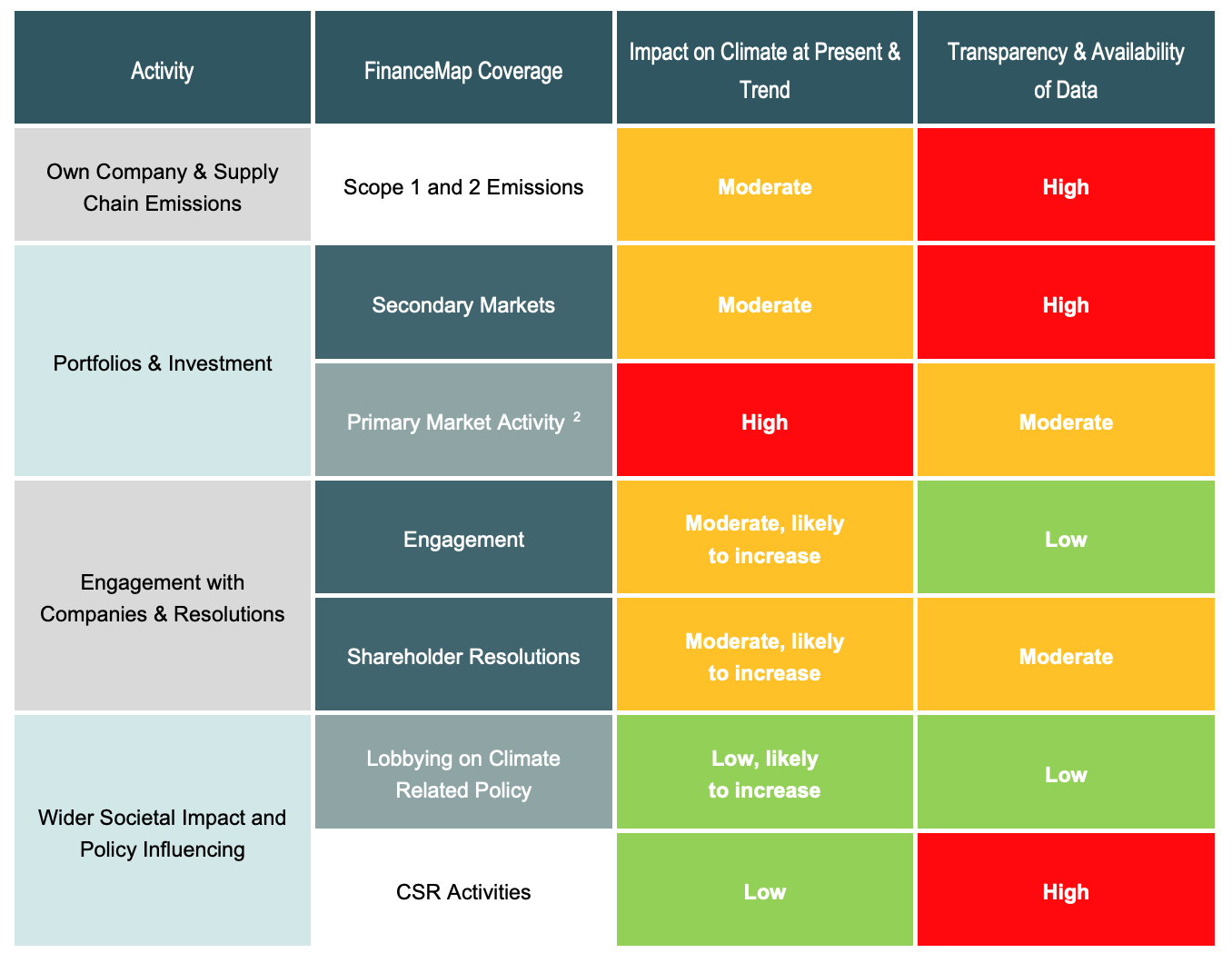
The Challenge
COP25 ended in December 2019 with little in the way of global political consensus on how to tackle the climate emergency. With national emissions targets putting the world on course for global warming of over 3°C, the historic Paris agreement to limit global temperature rise to no more than 2°C is under threat.
At the same time, the latest science shows that staying below 1.5°C of warming is vital for society and the economy. With governments failing to act, the onus is on the business and finance community to overdeliver on decarbonisation.
Much of the carbon-emitting activity in the world relies on financial support from banks, investors and asset owners (see figure below). Banks provide loans, or ‘bonds’ in the ‘primary’ market to support companies to build or operate assets, such as coal or cement plants. Investors then buy these bonds, or take shares in companies, in the ‘secondary’ market before pooling them together in ‘portfolios’ of assets. Finally, asset owners, like pension funds and insurers, give these investors large pots of money to invest in their portfolios.
 Much of the financial industry is now aware of the need to integrate climate change into its activities, but the extent to which it is doing so varies greatly. Asset owners need to know how each asset manager, and the companies in which they invest, are performing on climate change. They need to know not only how different investment portfolios measure up against the Paris agreement, but also what asset managers are doing to encourage their investee companies to reduce carbon intensity and align lobbying activities with climate goals.
Much of the financial industry is now aware of the need to integrate climate change into its activities, but the extent to which it is doing so varies greatly. Asset owners need to know how each asset manager, and the companies in which they invest, are performing on climate change. They need to know not only how different investment portfolios measure up against the Paris agreement, but also what asset managers are doing to encourage their investee companies to reduce carbon intensity and align lobbying activities with climate goals.
The Project
Aligning Portfolios with Paris (APWP), a project involving EIT Climate-KIC partners InfluenceMap and 2° Investing Initiative (2°ii). sets out to provides public-facing metrics and analysis of the financial sector through a climate lens. It focuses on driving the transition towards the Paris agreement across investment activity and fund portfolios, engagement activity, shareholder resolutions and corporate lobbying.
To date the project has focused on the secondary market, providing asset owners with detailed information on how different asset managers are performing in terms of meeting the Paris agreement. This has seen the launch of the FinanceMap tool which houses information on the funds of 4,000 asset managers. It shows how much the portfolio of each deviates from the Paris agreement across all high emitting industries like coal, oil and gas, shipping and steel.
 The APWP team have achieved this impressive output by drawing together data on high emitting assets like coal plants, or steel factories, and working out which companies own, or manage these assets. They then combine this data with information on the shares and bonds that make up the investment portfolios of each asset manager to reveal how the companies are represented across the different portfolios. Finally, each portfolio is compared with International Energy Agency Scenarios for meeting the Paris agreement.
The APWP team have achieved this impressive output by drawing together data on high emitting assets like coal plants, or steel factories, and working out which companies own, or manage these assets. They then combine this data with information on the shares and bonds that make up the investment portfolios of each asset manager to reveal how the companies are represented across the different portfolios. Finally, each portfolio is compared with International Energy Agency Scenarios for meeting the Paris agreement.
At present, the FinanceMap tool covers around 85% of global emissions and is based on a 1.75°C rise in temperature, until recently the most ambitious IEA scenario. A more ambitious 1.5°C scenario will soon be integrated, so asset managers can aim for the highest level of climate compliance.
Understanding where a particular portfolio is positioned in relation to the Paris agreement is a good start but is a limited ‘snapshot in time’ and does not provide any information on the engagement work that the asset manager might be undertaking in an effort to persuade its investee companies to reduce emissions.
The APWP team have developed a method to measure the robustness of different asset managers engagement activity and identify which have a process for reducing the climate impact of their investee companies. When combined with proxy voting records, which show how investors vote on climate resolutions at company meetings, this paints a more comprehensive picture of which investors are driving the low carbon transition and which are failing to act.
A complete understanding of different asset managers’ approach to climate change also requires an investigation of any lobbying activity, that pressures policymakers into diverging further from Paris goals, which they might be able to influence. At present, the team are working to develop the FinanceMap tool to reveal which investors and companies are particularly responsible for this detrimental work.
Impacts
The FinanceMap tool is now up and running and accessible to all, allowing asset owners, as well as the media and general public to gain a true picture of how their portfolios stack up against the Paris agreement. Capital held by asset owners makes up a sizeable proportion of total global wealth, with money managed in institutional pension funds valued at over $40tn, so the scope for these institutions to change the trend in global carbon emissions is huge.
The APWP project has already seen a lot of interest from the biggest asset owner in the world. Many, such as the New York State pension fund, CALPERS and faith funds such as Church of England pension fund are very keen to ensure their money is not invested with asset managers who are funding climate change and also encourage competitive improvement across the industry.
The results of the project are beginning to impact wider audiences too. Earlier this year, Influencemap released a study of 118 funds marketed with “an explicit climate theme”, finding that some had exposure to fossil fuels “with intensities comparable to mainstream funds”. This news gained wide media exposure across the financial and mainstream press.
At a deeper level, APWP’s engagement work is beginning to provide valuable information on which investors are working hard to encourage companies to reduce emissions and which are not. For example, the tool has exposed serious divergence between managers who oppose 95% of climate resolutions, and managers who work with companies to understand exactly what they need to change to meet Paris targets.
EIT Climate-KIC has been instrumental in introducing the APWP team to asset owners and managers and helping to steer their overall strategy. They have also helped the project stay connected to political and sustainable finance activities in the EU, which frame the macro-environment in which the team operates.

